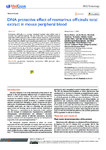
Please use this identifier to cite or link to this item:
http://ricaxcan.uaz.edu.mx/jspui/handle/20.500.11845/588| Title: | DNA protective effect of rosmarinus officinalis total extract in mouse peripheral blood |
| Authors: | Lazalde Ramos, Blanca Patricia Gómez Meda, Belinda Claudia Reyes Estrada, Claudia Araceli Ortíz García, Yveth Marlene Zamora Pérez, Ana Lourdes Gutiérrez Hernández, Rosalinda Morales Velazquez, Gabriela Quirarte Baez, Sol María Zúñiga González, Moisés Zúñiga |
| Issue Date: | 3-Apr-2018 |
| Publisher: | MedCrave Step into the world of research |
| Abstract: | Rosmarinus officinalis is a common household aromatic plant widely used in cosmetic, food and folk medicine. The aim of this study was evaluated rosmarinus total extract (RTE) protective effect on DNA damage induced by cyclophosphamide (CP) and evidence the lack of genotoxicity and cytotoxicity of RTE in peripheral blood erythrocytes of Balb-C mice using the micronucleus assay. To evaluate the DNA protective effect, the dose of 100mg/kg of RTE was used and given orally. Following was the admiration of CP (50mg/kg). To evaluated the lack genotoxic or cytotoxic, three doses (30, 100 and 300mg/kg) of RTE were administered orally. A drop of blood was obtained from the tip of the tail of each mouse 24h for six days. We found no increase of micronucleated erythrocytes (MNE) or micronucleated polychromatic erythrocytes (MNPCE). Nor did polychromatic erythrocytes (PCE) decline in mice treated with one of the three different doses of RTE. RTE extracts were capable of diminished DNA damage caused by CP thus reducing MNE and MNPCE frequencies. The lack of genotoxic and cytotoxic effect of the RTE and reduces the genotoxicity caused by CP, suggest the potential therapeutic usefulness of this plant extract. |
| Description: | Rosmarinus officinalis is a common household aromatic plant widely used in cosmetic, food and folk medicine. The aim of this study was evaluated rosmarinus total extract (RTE) protective effect on DNA damage induced by cyclophosphamide (CP) and evidence the lack of genotoxicity and cytotoxicity of RTE in peripheral blood erythrocytes of Balb-C mice using the micronucleus assay. To evaluate the DNA protective effect, the dose of 100mg/kg of RTE was used and given orally. Following was the admiration of CP (50mg/kg). To evaluated the lack genotoxic or cytotoxic, three doses (30, 100 and 300mg/kg) of RTE were administered orally. A drop of blood was obtained from the tip of the tail of each mouse 24h for six days. We found no increase of micronucleated erythrocytes (MNE) or micronucleated polychromatic erythrocytes (MNPCE). Nor did polychromatic erythrocytes (PCE) decline in mice treated with one of the three different doses of RTE. RTE extracts were capable of diminished DNA damage caused by CP thus reducing MNE and MNPCE frequencies. The lack of genotoxic and cytotoxic effect of the RTE and reduces the genotoxicity caused by CP, suggest the potential therapeutic usefulness of this plant extract. |
| URI: | http://hdl.handle.net/20.500.11845/588 https://doi.org/10.48779/ab63-h106 |
| ISSN: | 2379-6294 |
| Other Identifiers: | info:eu-repo/semantics/publishedVersion |
| Appears in Collections: | *Documentos Académicos*-- UA Medicina |
Files in This Item:
| File | Description | Size | Format | |
|---|---|---|---|---|
| MOJT-04-00093 DNA protective R. off.pdf | 588,25 kB | Adobe PDF |  View/Open |
This item is licensed under a Creative Commons License
